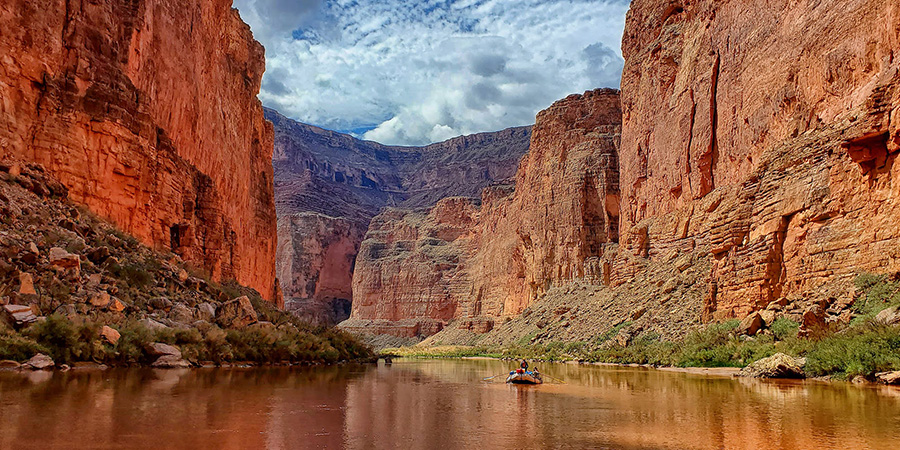
Did you know the Colorado River used to be called the Grand River? Learn about the name change and more fun facts about this hardworking river.
The Colorado River is one of the hardest working rivers in the Western United States. Flowing from the Rocky Mountains to Mexico, the river traverses 1,450 miles as it collects water from seven states — Wyoming, Colorado, Utah, New Mexico, Nevada, Arizona, and California. That water gets divvied out quickly. It supplies 40 million people and irrigates more than 5 million acres of farmland. The power generated from its largest dams — Glen Canyon Dam and Hoover Dam — supplies electricity from California to Wyoming.
The river has been a lifeline for people, plants, and wildlife for millennia. Here are four fun facts about the Colorado River:
1. The Colorado River used to be called the Grand River

Since time immemorial, Indigenous peoples have had connections to and names for the river now widely known as the Colorado. For the Havasupai, the river is “Ha’ gthayah,” which translates as “the big river” or “a lot of water coming through.” To the Hualapai, the Colorado River is known as “Ha’ Ka-Ama,” which translates as “flowing water.”
Until 1921, the river flowing west from the Continental Divide in Rocky Mountain National Park and winding down to the high desert of Utah was known as the Grand River. Where the Green River and the Grand River met, the Colorado River began and flowed downstream to the Gulf of California. The name Colorado River, meaning the red river, came from Spanish explorers in the 16th century. Heavy with silt, the river, in its natural state, often flowed red.
A Colorado congressman took it upon himself to have the headwaters renamed to better emphasize the state in which the river began. And on July 25, 1921, the U.S. House of Representatives passed a joint resolution to make it official. Grand Lake, Grand County, and the city of Grand Junction are all reminders of its former name.
2. The Colorado River is a living entity

The confluence of the Colorado and Little Colorado Rivers, in the Grand Canyon. BLAKE MCCORD
Indigenous peoples have celebrated, cherished, and respected Colorado River water since time immemorial. For the Diné, the Colorado River is considered the male river. It meets up with the female river at its confluence with the Little Colorado River. To the Hualapai, the middle of the Colorado River is the backbone of the people.
“Before the dam, our people walked across the river when it was low…I know it’s hard for people to understand, but for us, our people are still there. They’re just like walking people, not spirits, but actually in the canyon like when they were alive a long time ago. And with the water constantly flowing after the dam, they can’t go and visit with their families or friends on the other side of the river,” says Zuni Cultural Advisor Octavius Seowtewa.
Colorado River water has been harnessed to provide for a way of life since long ago. For example, in the lower Colorado River Basin, the Hohokam people built irrigation canals on the Gila River, a tributary to the Colorado River, as well as on the Salt River, which flowed into the Gila. Yuman tribes long practiced floodplain farming using Colorado River water.
3. The Colorado River feeds the largest reservoir in the United States

Lake Mead, formed by the construction of Hoover Dam in 1936, is the largest reservoir in the United States by volume. Located east of Las Vegas, Nevada, when full it holds 9.3 trillion gallons of water — equivalent to two years’ worth of Colorado River flows.
Lake Powell, formed by Glen Canyon Dam in 1963, is the largest reservoir in the U.S. by surface area. Over 1,960 miles of winding shoreline outline the reservoir when it’s full. Combined, these two reservoirs act as a “bank account.” They hold over 17 trillion gallons of water, enough to fill over 25 million Olympic-sized swimming pools.
Both reservoirs were created to manage floodwaters, store vital water in the arid Southwest, and generate power. The U.S. Bureau of Reclamation manages water and power deliveries from Lake Mead and Lake Powell.
4. The Colorado River is a losing river

Most rivers get bigger as they flow downstream, collecting water from creeks, streams, and other tributaries. However, the Colorado River has such an extensive plumbing system made up of dams, canals, pipelines, and diversions, that more water leaves the river than comes in. Because of this, the Colorado River no longer reaches the sea.
The Central Arizona Project is a modern-day artificial river, delivering Colorado River water 336 miles from Lake Havasu to the bustling cities of Phoenix and Tucson, Arizona. The concrete-lined channels wind across some of the hottest, driest parts of the state using 14 huge pumps to move water uphill. More than a billion gallons of water a day can be transported 242 miles west across California to supply water to Los Angeles and San Diego via the Colorado River aqueduct. In the upper reaches of the Colorado River, tunnels under the Rocky Mountains divert water across the Continental Divide to supply Denver, Colorado Springs, and growing populations outside of the Colorado River Basin.
Our warming climate is expected to reduce snowpack, increase evaporation, and reduce Colorado River flows. Short-term fixes have kept the water flowing, but it will take big changes to quench our thirst for this hardworking river.




